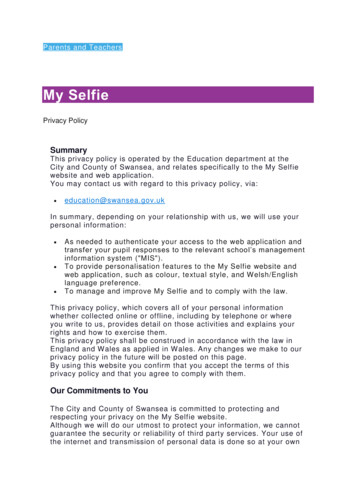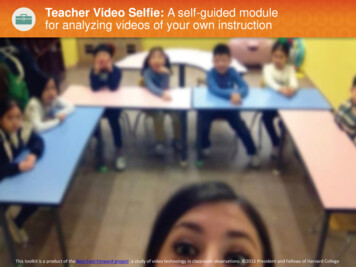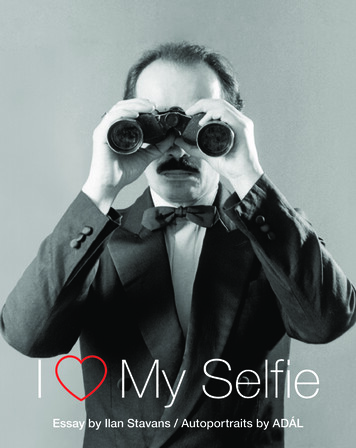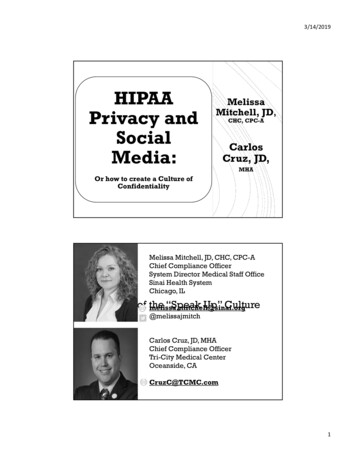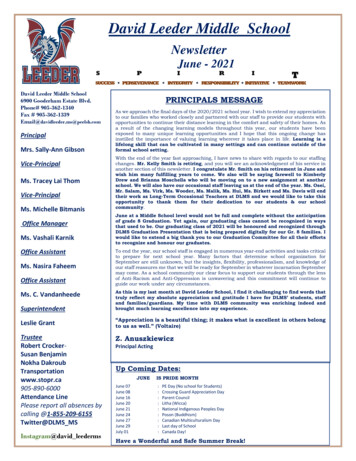
Transcription
Me, My Selfie, and ICitation for published version (APA):Veldhuis, J., Alleva, J. M., de Vaate, A. J. D. B., Keijer, M., & Konijn, E. A. (2020). Me, My Selfie, and I:The Relations Between Selfie Behaviors, Body Image, Self-Objectification, and Self-Esteem in YoungWomen. Psychology of Popular Media, 9(1), 3-13. https://doi.org/10.1037/ppm0000206Document status and date:Published: 01/01/2020DOI:10.1037/ppm0000206Document Version:Publisher's PDF, also known as Version of recordDocument license:TavernePlease check the document version of this publication: A submitted manuscript is the version of the article upon submission and before peer-review. There canbe important differences between the submitted version and the official published version of record.People interested in the research are advised to contact the author for the final version of the publication,or visit the DOI to the publisher's website. The final author version and the galley proof are versions of the publication after peer review. The final published version features the final layout of the paper including the volume, issue and pagenumbers.Link to publicationGeneral rightsCopyright and moral rights for the publications made accessible in the public portal are retained by the authors and/or other copyrightowners and it is a condition of accessing publications that users recognise and abide by the legal requirements associated with theserights. Users may download and print one copy of any publication from the public portal for the purpose of private study or research. You may not further distribute the material or use it for any profit-making activity or commercial gain You may freely distribute the URL identifying the publication in the public portal.If the publication is distributed under the terms of Article 25fa of the Dutch Copyright Act, indicated by the “Taverne” license above,please follow below link for the End User Agreement:www.umlib.nl/taverne-licenseTake down policyIf you believe that this document breaches copyright please contact us at:repository@maastrichtuniversity.nlproviding details and we will investigate your claim.Download date: 22 Sep. 2022
Psychology of Popular Media 2018 American Psychological Association2689-6567/20/ 12.002020, Vol. 9, No. 1, 3–13http://dx.doi.org/10.1037/ppm0000206Me, My Selfie, and I: The Relations Between Selfie Behaviors, BodyImage, Self-Objectification, and Self-Esteem in Young WomenJolanda VeldhuisJessica M. AllevaVrije Universiteit AmsterdamMaastricht UniversityThis document is copyrighted by the American Psychological Association or one of its allied publishers.This article is intended solely for the personal use of the individual user and is not to be disseminated broadly.Anna J. D. (Nadia) Bij de Vaate, Micha Keijer, and Elly A. KonijnVrije Universiteit AmsterdamDue to the enormous popularity of social networking sites (SNSs), online and offline social lives seeminextricably linked, which raises concerns for how SNS use relates to psychological health. Similarly, theomnipresence of selfies on SNSs—a form of appearance-related exposure—raises concerns regardingpsychological health. This study aimed to investigate the relationships between body image, selfobjectification, self-esteem, and various selfie behaviors among young women (N 179). We hypothesized that a worsened body image (i.e., higher body dissatisfaction or lower body appreciation), higherlevels of self-objectification, and lower self-esteem would precede greater engagement in selfie behaviors. Structural equation modeling showed that body appreciation is associated with greater engagementin selfie selection and deliberate posting, and that self-objectification is related to greater engagement inall selfie behaviors assessed. In support of our proposed model, a reversed model was also tested thatshowed poorer results. These findings suggest that body image may serve not only as an outcome of SNSuse but also as a motive preceding selfie behaviors.Public Policy Relevance StatementBecause many young people use social network sites (SNSs) and selfies extensively in their everydaylives, it is important to better understand the (reciprocal) relations between SNSs and selfies on theone hand, and body image and self-esteem on the other hand. Results from our study showed thatyoung women who appreciated their body to a higher extent were also very likely to be engaged inselecting their selfies and deliberate selfie posting on SNSs, and those who regarded their bodiesmore as physical objects were also more engaged in selfie behaviors pertaining to selecting, editing,and online posting of selfies. Further, guiding future research and intervention development, ourresearch findings imply that SNS use and body image are intertwined, in that body image serves notonly as an outcome of SNS use but also as a motive for being engaged in selfie behaviors.Keywords: selfies, body image, self-objectification, self-esteem, online self-presentationcessed websites on the Internet (Tiggemann & Slater, 2014).Unlike traditional forms of media, such as magazines or movies,SNSs allow individuals to be both consumers and producers ofcontent (Holland & Tiggemann, 2016). For instance, SNS userscan selectively choose to join a group, share content, post theirown content, and post status updates, videos, images, or tweets.Moreover, many people can no longer avoid social media, as theyare used for communication in various settings of daily life, suchas school or work. The widespread use of SNS seems currentlyindispensable in everyday life and with that, online and offlinesocial lives seem inextricably linked to each other. This state ofaffairs most likely has implications for social relationships, health,and well-being, and consequently, researchers increasingly examine how SNS use relates to various aspects of psychological health(Kim & Lee, 2011; Strubel, Petrie, & Pookulangara, 2016; Valenzuela, Park, & Kee, 2009). One specific form of SNS use, whichbegan just a few years ago, has quickly become one of the mostSocial media are extremely popular, with 86% of 18 –29-yearold individuals accessing social networking sites (SNSs) such asFacebook, Instagram, Pinterest, and Twitter (Pew Research Center, 2017). In fact, SNSs have become the most commonly ac-This article was published Online First August 20, 2018.Jolanda Veldhuis, Department of Communication Science, Vrije Universiteit Amsterdam; Jessica M. Alleva, Department of Clinical Psychological Science, Maastricht University; Anna J. D. (Nadia) Bij de Vaate,Department of Communication Science, Vrije Universiteit Amsterdam;Micha Keijer, Department of Sociology, Methods and Statistics Science,Vrije Universiteit Amsterdam; Elly A. Konijn, Department of Communication Science, Vrije Universiteit Amsterdam.Correspondence concerning this article should be addressed to JolandaVeldhuis, Department of Communication Science, Vrije Universiteit Amsterdam, De Boelelaan 1081, 1081 HV Amsterdam, The Netherlands.E-mail: j.veldhuis@vu.nl3
4VELDHUIS, ALLEVA, BIJ DE VAATE, KEIJER, AND KONIJNThis document is copyrighted by the American Psychological Association or one of its allied publishers.This article is intended solely for the personal use of the individual user and is not to be disseminated broadly.popular activities: posting selfies. Selfies refer to pictures of oneself, taken by oneself (Fox & Rooney, 2015). More than 17 millionselfies are uploaded to social media each week (Winter, 2014), and“photo-sharing social networking sites (SNSs) have created a‘selfie-craze’” (Lee & Sung, 2016, p. 347). Today, on Instagramalone, 337 million selfies can be found through #selfie (Instagram,2018). The abundant use of selfies similarly raises questions concerning psychological health and well-being, as elaborated below.The present article aims to investigate the relationships betweenselfie behaviors and body image, self-objectification, and selfesteem in young women.Selfies and Body ConcernsBody image consists of an individual’s thoughts, feelings, andperceptions of his or her own body (Cash, 2004). Many studies thathave investigated the relationship between SNS use and psychological health have included assessments of body image. A recentsystematic review has reported a relation between SNS use andbody image-related outcomes (Holland & Tiggemann, 2016). Thisreview found that, across methodologies, SNS use was associatedwith indices of a negative body image, such as greater bodydissatisfaction and body concern (see also Strubel et al., 2016).However, given that not all studies found a relationship betweenSNS use and a more negative body image, Holland and Tiggemann(2016) advised that investigating specific aspects of SNS use mayprovide more useful information than looking at overall SNS usealone (e.g., number of hours spend on Facebook). Indeed, Meierand Gray (2014) found that overall Facebook use was not relatedto a more negative body image, but specifically exposure toappearance-related content on Facebook was. Similarly, Thompson and Lougheed (2012) found that particularly exposure toFacebook pictures instigated a negative body image. Hence,appearance-focused content (like pictures) is more likely to influence body-related concepts, because it instigates comparison inthis domain (cf. social comparison theory; Festinger, 1954; Jones,2001; Schutz, Paxton, & Wertheim, 2002). In line with this, Meierand Gray (2014) concluded that engaging in appearance-relatedactivities on Facebook, such as posting photos of oneself and one’sfriends, was associated with increased weight dissatisfaction, drivefor thinness, internalization of appearance ideals, and selfobjectification. The latter refers to the tendency to evaluate andvalue oneself based predominantly on appearance, rather thanother, internal qualities of the self (Fredrickson & Roberts, 1997;Meier & Gray, 2014).Selfies particularly pertain to appearance-related exposure onSNSs. McLean, Paxton, Wertheim, and Masters (2015) were thefirst to look specifically at the potential role of taking and sharingselfies as one specific form of appearance-related exposure onSNSs. Namely, they investigated the roles of photo investment,including concerns about photo quality and how photos portray theindividual, and photo manipulation, referring to the use of photoediting techniques prior to sharing. Their results showed that largerengagement in selfie-related SNS use was related to more bodyconcerns among young women, and this relationship was strongerfor those reporting more photo investment and manipulation. Similarly, a recent study by Cohen and colleagues (Cohen, NewtonJohn, & Slater, 2017) showed that taking and sharing selfies wasassociated with increased body dissatisfaction and bulimia symptomatology among young women.The current study contributes to the present literature on SNSuse, selfies, and body image in several ways. Theorizing andprevious studies on the associations between SNS use and bodyrelated outcomes show inconsistencies. Most research argues fromSNS use to (negative) body-related outcomes; however, we arguethat a reversed process is also possible. That is, specific media areutilized to meet specific needs (cf. uses-and-gratifications theory;Katz, Blumler, & Gurevitch, 1973). In the following, we will firstbriefly review the most commonly applied theories and then elaborate on our “reversed process.”Research on SNSs and body image thus far has proposed thatengaging in SNSs (including taking and sharing selfies) can causea more negative body image and higher self-objectification (Cohenet al., 2017; Holland & Tiggemann, 2016; McLean et al., 2015).Two theories commonly used to explain this relationship are thesociocultural theory (Thompson, Heinberg, Altabe, & TantleffDunn, 1999) and objectification theory (Fredrickson & Roberts,1997). In brief, the sociocultural theory proposes that media canencourage women to internalize the beauty ideal and engage inappearance-based social comparisons with the women in suchimagery. As this beauty ideal becomes important—yet can almostnever be achieved—women may experience a negative body image. In the specific case of selfies, the images can be body centricor facial centric. Here, the beauty ideals for women pertain to bodyfeatures such as being slender, toned, and fit (Grabe, Ward, &Hyde, 2008; Tiggemann & Zaccardo, 2015) and facial featureslike, for example, having a smooth skin, large eyes, a slim face,and full lips (also see Pusic, Klassen, Scott, & Cano, 2013).Holland and Tiggemann’s review (2016) showed that the relationship between SNS use and a more negative body image wasmediated by appearance-based social comparisons and internalization of appearance ideals, supporting the sociocultural theory.In a similar line of thought, objectification theory proposes thatliving in a society in which women are viewed and evaluated basedpredominantly on their appearance can encourage girls and womento engage in self-objectification (Lindberg, Hyde, & McKinley,2006). In turn, self-objectification can foster a negative bodyimage. Put differently, the internalization of a body-focused viewof the female body results in experiencing objectified body consciousness, which entails the constant assessment of one’s looks(so-called body surveillance) and negative emotions regardingone’s body, such as being ashamed (so-called body shame; Forbes,Jobe, & Revak, 2006; Knauss, Paxton, & Alsaker, 2008). Also,Cohen and colleagues (2017) found support for the objectificationtheory, as their findings showed that the relationship betweenselfie activities and a more negative body image was moderated byself-objectification.In light of these theories, posting selfies on social media maysimilarly have negative effects on body image (Holland & Tiggemann, 2016). These theories are valuable for explaining how SNSuse can cause a more negative body image. However, from theuses-and-gratifications theory (Katz et al., 1973), another possibility should be considered, namely that specific media are selected to meet specific needs. More specifically, the uses-andgratifications theory proposes that this process is guided bypsychological factors (Katz et al., 1973). Additionally, Walther’shyperpersonal model (1996) underlines such selective use of me-
This document is copyrighted by the American Psychological Association or one of its allied publishers.This article is intended solely for the personal use of the individual user and is not to be disseminated broadly.SELFIES, BODY IMAGE, AND SELF-OBJECTIFICATIONdia, and further explicates that the affordances and features of theInternet allow for selective self-presentation and careful identityconstruction. Furthermore, Fox and Vendemia (2016) specificallyclaimed that SNSs allow selective self-presentation through pictures. Gonzales and Hancock (2011) argued that self-presentationsin the online world impact users’ self-concepts in the offline world.In particular, they found that becoming self-aware by updating andviewing one’s own Facebook profile enhanced rather than diminished users’ self-esteem. Moreover, individuals, in general, selectpictures that make them look as good as possible (Young, 2009),and people seem to post pictures on SNSs that often tend to stretchthe truth a bit (Zhao, Grasmuck, & Martin, 2008). Media’s currentfeatures allow users to rather easily manipulate pictures beforeputting them online, for example, by applying filters (e.g., Snapchat) or editing software like Photoshop. The conclusions fromprevious research underpin our argument, studied in the currentarticle, that SNSs could be used to reinforce and empower oneself(cf. reasoning in Tiidenberg, 2014; Tiidenberg & Cruz, 2015).In applying the above reasoning to the selfie theme, we aimed totest the possibility that women who have a negative body imageand higher levels of self-objectification could be more motivated touse SNSs and engage in selfie behaviors. Put differently, individuals may receive encouragement via SNSs by means of positivefeedback on presenting desired identities through selfies (Barry,Doucette, Loflin, Rivera-Hudson, & Herrington, 2017). Then, using SNSs for posting selfies might offer options for selfenhancement that fit individuals’ psychological states and motives.For example, for a woman with a negative body image, thispsychological factor of body image may guide specific media usein terms of taking, editing, and sharing selfies on her Facebookpage being motivated by the hope of receiving positiveappearance-related feedback (motivation; also cf. Bij de Vaate,Veldhuis, Alleva, Konijn, & Van Hugten, 2018). Similarly, thepsychological factor of experiencing greater self-objectificationcould motivate a woman to monitor her appearance by engaging inspecific media use such as taking selfies, and sharing these selfiescould endorse that she is doing well with regard to emulating thebeauty ideal (Fredrickson & Roberts, 1997; Moradi & Huang,2008). In all, such reasoning positions a negative body image andincreased self-objectification as a motivation for engagement inselfie behaviors, rather than selfie behaviors as antecedents to anegative body image and increased self-objectification.Hence, given the appearance-focused nature of selfies and thepossibilities of SNSs to get immediate feedback that could bemotivational and encouraging in nature, we hypothesized a reversed process than is studied thus far. That is, we propose that anegative body image (i.e., relatively higher levels of body dissatisfaction and lower levels of body appreciation), higher levels ofself-objectification, and lower self-esteem would enhance greaterengagement in various selfie behaviors. Thus, in the present study,we investigated whether SNS use can be a solution to fit anindividual’s psychological state and motives, rather than or inaddition to being an antecedent to negative body image and selfobjectification.A second contribution of the current study is exploring therelationship between self-esteem and various selfie behaviors. Selfesteem is generally defined as the way individuals feel aboutthemselves, and as individuals’ attitude toward themselves intotal (Brown & Marshall, 2006; Rosenberg, Schooler, Schoen-5bach, & Rosenberg, 1995). Hence, it is conceptualized as amore general measure, indicating an important aspect of wellbeing than the previously described body-centered concepts(i.e., satisfaction with one’s body, appreciation of one’s body,and self-objectification).Research has shown that self-esteem is related to body image(Cash & Fleming, 2002) and self-objectification (Moradi &Huang, 2008), and bolstering self-esteem has been identified as akey motivator for selecting specific forms of media (Valkenburg,Peter, & Walther, 2016). Moreover, young adult women indicatedposting selfies as a motive to push forward a positive self andtherewith increase self-esteem (Pounders, Kowalczyk, & Stowers,2016). Such a finding underpins our assumption that selfie behavior could be portrayed to empower and reinforce oneself (Tiidenberg, 2014; Tiidenberg & Cruz, 2015). Thus, following theorizingalong the lines of the uses-and-gratifications theory (Katz et al.,1973), lower self-esteem (i.e., a psychological factor) could encourage one to take selfies that align with a desired identity (i.e.,specific media use), in the hopes of receiving encouragement viaSNSs (i.e., motivation; Barry et al., 2017). The current studytherefore investigated whether lower self-esteem would precede astronger tendency to engage in selfie behaviors.Lastly, the current study contributes to the present literature byinvestigating selfie behavior in terms of its various aspects, including preoccupation, selection, editing, and deliberate posting (ratherthan the commonly studied overall SNS use alone; Bij de Vaate etal., 2018). Namely, prior to selfie-making, individuals are, to acertain degree, preoccupied or involved with selfies, for example,by looking at or commenting on selfies of friends on Facebook.After taking selfies, individuals consciously select the one theywould like to post online (Siibak, 2009). Subsequently, manyediting techniques can be used (e.g., filters; Fox & Rooney, 2015).Finally, the (edited) selfie can be deliberately posted online. Asthis sequence demonstrates, various selfie-related behaviors caneach contribute to eventual selfie curation and deliberate selfieposting. Because selfie taking and sharing alone do not comprisethe efforts and thoughts that have been put into curating theironline self-presentation, it is important to also investigate behaviors preceding deliberate selfie posting.Overview of the Current StudyIn sum, this study investigated the relationships between bodyimage, self-objectification, self-esteem, and various selfie behaviors, and contributes to the current body of literature in three ways:(a) Research on SNSs and body image has proposed that engagingin SNSs (including taking and sharing selfies) can lead to a morenegative body image and higher self-objectification; however,based on theorizing that media are selected to meet specific needs,this study investigated whether women who have a more negativebody image and higher levels of self-objectification are moremotivated to use SNSs and engage in selfie behaviors; (b) thisstudy examined the relationship between self-esteem and the various selfie behaviors; and lastly (c), this study investigated selfiebehavior in terms of its various aspects, including preoccupation,selection, editing, and deliberate posting.More specifically, in line with the uses-and-gratifications theory(Katz et al., 1973) and the hyperpersonal model (Walther, 1996),we hypothesized that a worsened body image (i.e., higher levels of
VELDHUIS, ALLEVA, BIJ DE VAATE, KEIJER, AND KONIJNThis document is copyrighted by the American Psychological Association or one of its allied publishers.This article is intended solely for the personal use of the individual user and is not to be disseminated broadly.6body dissatisfaction, Hypothesis 1a, and lower levels of bodyappreciation, Hypothesis 1b), higher levels of self-objectification(Hypothesis 2), and lower self-esteem (Hypothesis 3) would precede higher engagement in the various selfie behaviors (see Figure1 for a schematic representation).Our target group comprised women between 18 and 25 yearsold. This age-group is considered as the developmental stage ofemerging adulthood (Arnett, 2000; Nelson, Story, Larson,Neumark-Sztainer, & Lytle, 2008), and it forms an ideal age-groupfor studying the proposed relationships for the following threereasons. First, emerging adults are among the largest consumers ofSNSs (Pew Research Center, 2017). Second, young women areamong the most frequent producers of selfies (Sorokowska et al.,2016). Third, young women are also most prone to experiencingbody concerns and self-objectification (Fredrickson & Roberts,1997).MethodParticipantsParticipants were 179 young females (Mage 21.54, SDage 2.05) who were selected from an initial sample of 252 women whoresponded to our online survey. Respondents who did not meet ourinclusion criteria were discarded. Our inclusion criteria were asfollows: (a) aged 18 to 25 years old (i.e., in the developmentalstage of emerging adulthood; Arnett, 2000; Nelson et al., 2008);(b) reported taking selfies (“Do you ever take selfies?”; yes/no);and (c) completed the entire survey. Participants completed highereducation (69.8%), middle education (23.5%), and lower education (6.7%). Participants’ body mass indices were normally distributed (M 21.95, SD 2.73; range 16 –32; calculated bydividing one’s self-reported weight in kilos by squared selfreported height in meters).ProcedureThe survey was distributed online through snowball samplingvia connections and several group pages on Facebook (i.e., beingclassified as the most popular SNS; Pew Research Center, 2017),as well as on the group page of a higher educational institution.Recruitment also occurred face-to-face and via leaflets on campuses of higher educational institutions. In all cases, participantswere referred to the online questionnaire. The first page of thesurvey informed participants generally about the study topic (i.e.,profiling selfie behavior), compensation, and inclusion criteria.After completing an electronic informed consent sheet, participants completed measures concerning demographics (i.e., age,weight, height, educational level), and daily Internet and SNS use.Subsequently, they completed measures concerning selfie behaviors, body image, self-objectification, and self-esteem. Lastly, participants were debriefed upon completion and rewarded with research credit or a chance to win a gift voucher.MeasuresFor scale uniformity, all scales (except for the Internet and SNSuse) that are subsequently addressed in more detail, were 5-pointLikert-type scales (e.g., 1 totally disagree to 5 totally agree;1 never to 5 very often). Scores were calculated as meanindices.Selfie measures. The following measures were composed byadapting measures from related areas such as Facebook use, adjusted to fit the selfie behaviors (also cf. Bij de Vaate et al., 2018).Preoccupation with selfies. The Photo Subscale (Meier &Gray, 2014; original .82) was adjusted to target selfies (e.g.,“I often share selfies”). For this study, we adapted the originaleight items to fit selfie-related activities and added an extra item onsharing selfies. Higher scores reflect higher engagement in onlineactivities indicative of preoccupation with selfies (nine items;current .74).Deliberate selfie selection. The Photo-Selection Scale (Siibak,2009) was adjusted to assess reasons why participants selectedselfies before posting them on SNSs (“How often do you select aselfie for that particular reason,” e.g., “Because friends and familyare in the selfie”). Higher scores indicate more deliberate andplanned consideration of specific reasons for selfie selection before online posting (15 items; .88).Editing of selfies. Three items (Fox & Rooney, 2015; original .88) were administered that are indicative of how oftenparticipants apply photo-editing techniques to improve their appearance before posting selfies online (“How often do you applyFigure 1. Proposed model for body dissatisfaction, body appreciation, self-objectification, and self-esteemaffecting selfie behaviors in young women.
This document is copyrighted by the American Psychological Association or one of its allied publishers.This article is intended solely for the personal use of the individual user and is not to be disseminated broadly.SELFIES, BODY IMAGE, AND SELF-OBJECTIFICATIONthe following techniques before posting a selfie on social media,”e.g., using filters, cropping, and applying Photoshop or otherediting software). Higher scores indicate larger use of photoediting techniques (current .63).Deliberate selfie posting. Deliberate selfie posting was assessed by four items measuring the extent to which participantsplan posting selfies for specific reasons (e.g., “Sometimes I postpone posting my selfie, so more people can like my selfie”).Higher scores indicated higher levels of deliberate selfie posting( .96).Body image measures. In line with recent research showingthat negative and positive body images are distinct (Tylka &Wood-Barcalow, 2015), we chose one measure to assess aspects ofa negative body image (body dissatisfaction) and one measure toassess aspects of a positive body image (body appreciation).Body dissatisfaction. Based on the Body Dissatisfaction Subscale of the Eating Disorder Inventory (Garner, Olmstead, &Polivy, 1983; original .89), the measurement for body dissatisfaction comprised nine items (e.g., “I think my hips are too big;cf. Veldhuis, Konijn, & Seidell, 2014a). Higher scores reflecthigher levels of body dissatisfaction (current .89).Body appreciation. The Body Appreciation Scale-2 (Alleva,Martijn, Veldhuis, & Tylka, 2016; Tylka & Wood-Barcalow,2015) comprises 10 items (e.g., “I respect my body”). The BodyAppreciation Scale-2 has shown to be reliable (previous internalconsistency estimates: 0.96 –0.97) and unidimensional across sexand type of sample (Andrew, Tiggemann, & Clark, 2015; Tylka &Wood-Barcalow, 2015). Higher scores demonstrate higher levelsof body appreciation (current .92).Self-objectification. Self-objectification was evaluated withfour items (e.g., “I often think about how I look”) from the BodySurveillance Subscale of the Objectified Body ConsciousnessScale for Preadolescent and Adolescent Youth (previous internalconsistency estimates vary between 0.79 and 0.89 across sex anddifferent samples; based on Lindberg, Hyde, & McKinley, 2006;cf. Veldhuis et al., 2014a). Higher scores indicate higher levels ofself-objectification (current .81).Self-esteem. The Rosenberg Self-Esteem Scale (Rosenberg,1965; original internal consistency: 0.77) comprises 10 items (e.g.,“I feel that I have a number of good qualities”) that assess traitself-esteem. Higher scores indicate higher self-esteem (current .83).Internet and SNS use. For additional insights on selfiemaker’s Internet and SNS behavior, we assessed daily Internet7access (e.g., at home, at school, or at work; yes/no) and dailyamount of Internet use (Meier & Gray, 2014). For the latter, theanswering options were based on the national mean of dailyInternet use for ages 18 –24 years being 3.3 hr per day (for answercategories, see Table 1; Bij de Vaate et al., 2018). Use of specificSNSs was measured by having a social media account (yes/no) anddaily amount of time spent on Facebook, Twitter, Instagram,Pinterest, and Tumblr (for answer categories, see Table 1; Bij deVaate et al., 2018).ResultsDescriptions and CorrelationsApproximately half of the participants (n 89) spent more than3 hr daily on the Internet, and Facebook was the most popu
levels of self-objectification, and lower self-esteem would precede greater engagement in selfie behav-iors. Structural equation modeling showed that body appreciation is associated with greater engagement in selfie selection and deliberate posting, and that self-objectification is related to greater engagement in all selfie behaviors assessed.


